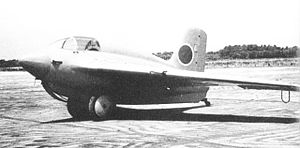Yokosuka MXY8
| MXY8 Akigusa | |
|---|---|
 | |
| Role | Training Glider Type of aircraft |
| National origin | Japan |
| Manufacturer | Yokosuka Naval Air Technical Arsenal |
| Variants | Yokosuka MXY9 |
The Yokosuka MXY8 Akigusa (秋草, "Autumn grass") was a training glider built in parallel with the Mitsubishi J8M rocket-powered interceptor aircraft.
Design and development
The J8M was to have simply been a licence-built Messerschmitt Me 163 Komet, but due to difficulties in obtaining technical materials from Germany, it eventually had to be designed almost from scratch.[1] The MXY8 was designed in parallel with the J8M to validate the design, and then to provide pilot training during the development of the actual interceptor.[2] The Army designation for the type was Ku-13.[3]
The MXY8 was built entirely of wood, and fitted with ballast tanks that would be filled with water to simulate the weight and therefore flight characteristics of a fully equipped J8M. Some 50-60 of these gliders were eventually built.
A more advanced trainer, the MXY9, equipped with a primitive jet engine was planned, but was never produced.[4]
Many sources apply the designation MXY8 to the Yokosuka MXY7 Ohka kamikaze weapon.
Specifications

Data from Japanese Aircraft of the Pacific War[5]
General characteristics
- Crew: 1
- Length: 6.05 m (19 ft 10 in)
- Wingspan: 9.5 m (31 ft 2 in)
- Height: 2.7 m (8 ft 10 in)
- Wing area: 17.73 m2 (190.8 sq ft)
Performance
See also
Related development
- Messerschmitt Me 163
- Mitsubishi J8M
- Yokosuka MXY9
References

- Notes
- ^ Francillon 1979, p. 404.
- ^ Francillon 1979, p. 405.
- ^ Francillon 1979, pp. 405–406.
- ^ Francillon 1979, p. 406.
- ^ Francillon 1979, p. 407.
- Bibliography
- Francillon, René J. (1979) [1970]. Japanese Aircraft of the Pacific War (2nd ed.). London: Putnam & Company Ltd. ISBN 0-370-30251-6.
- v
- t
- e
- B3Y
- B4Y
- Ro-go Ko-gata
- E1Y
- Tatsu-go
- 1-go
- E5Y
- E6Y
- E14Y











